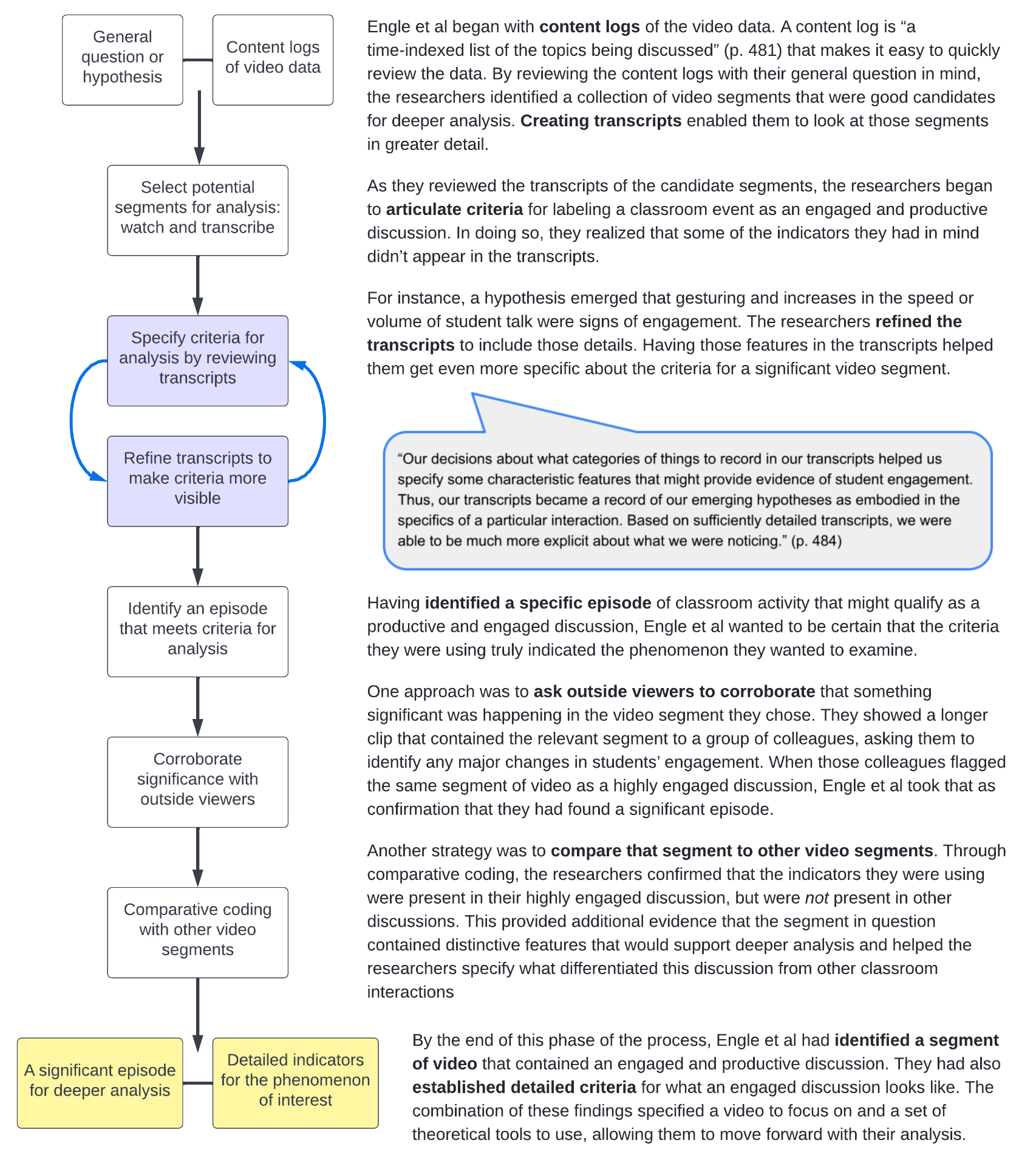An analysis is never completely inductive or “grounded”. As researchers, we always come to a project with some area of interest, some ideas about what we expect to find, and some sense of how we will recognize the thing we’re looking for.
At the same time, research calls for us to examine phenomena that we don’t yet understand. We can’t know in advance what will be important or insightful, so we have to be prepared to develop our hypotheses as we explore the data.
The challenge for researchers is to balance these two aspects: how can we simultaneously be oriented by hypotheses and also be open to following what the data reveals? How can we develop more specific explanatory theories without imposing them on the data or constraining the analytic process?
In “Progressive Refinement of Hypotheses in Video-Supported Research” (2007), Drs. Randi Engle, Faith Conant, and James Greeno suggest that conducting this kind of analysis effectively requires “progressive refinement of hypotheses.” As researchers look at the data, their hypotheses get more specific. These updated hypotheses are then used to examine the data more closely, which continues to refine the hypotheses. Through this cycle, researchers can construct more detailed and insightful explanations for what they see in the data.
Engle, Conant, & Greeno illustrate how they use video data to support progressive refinement of hypotheses by walking through an analysis they conducted together. By considering how multiple re-viewings of their data helped them develop more specific explanatory theories, we can see how this process might unfold in other video-supported research.
Why use video for this process?
Video provides a more comprehensive record than other methods, like field notes or coding sheets, because it captures more complete events. A video contains more detail than other forms of data and it captures that detail more holistically, without requiring researchers to determine in advance what is worth including.
This allows researchers to re-view events as they figure out what was significant, instead of having to decide in the moment what details are important. Re-viewing video often reveals important phenomena that researchers had not even noticed during the event or on the initial viewing.
What follows is a graphic illustration of their approach to inductive video analysis. The flowcharts on the left side summarize the steps of the process. The text on the right side provides more detail about what those steps entail, including examples from the authors’ study.
The overall process they describe looks something like this:
What does initial analysis look like?
Initial analysis has to accomplish two main goals: identifying a segment of video to focus on and specifying what is noteworthy in that segment. To put it another way: what is the phenomenon you’re looking for, and where do you think you’re seeing it?
These two goals work together: the task of identifying an episode that showcases the phenomenon pushes you to be explicit about what the indicators of that phenomenon are. How do you know that some particular segment of video is a good example of the thing you want to examine? What are the criteria that make a segment of video worth analyzing? Specifying those criteria, in turn, provides indicators that help you to identify and validate examples of the phenomenon. By engaging in this cyclical process, a researcher can get specific about the material they’re working with and the analytic tools they’re using.
Refining and specifying a model
Initial analysis can lead researchers to some insights, but it also sets up the next phase of analysis. Now that you have a clearer sense of what you’re looking for and how to make it visible, the process leads into cycles of refining your hypotheses with deeper analysis and applying them to a wider range of data.
So, what now?
One of the challenges of inductive research is that you’re never truly finished with an analysis. You can always pursue more detail, or look at more data, or compare with more cases. With video, you can even start a completely new analysis with the same data. Depending on your context, your data collection, and your research questions, every analysis will be a bit different – which means that this guide can’t give you straightforward step-by-step instructions. Even so, we hope that the process we outlined and described here can provide you with a sense of direction in your research and set you up for success as you undertake your own inductive analyses. Good luck!
References
Engle, R., Conant, F., & Greeno, J. (2007). Progressive refinement of hypotheses in video-supported research. In R. Goldman, R. Pea, B. Barron, & S. Derry (Eds.), Video research in the learning sciences (pp. 239-254). Routledge.





